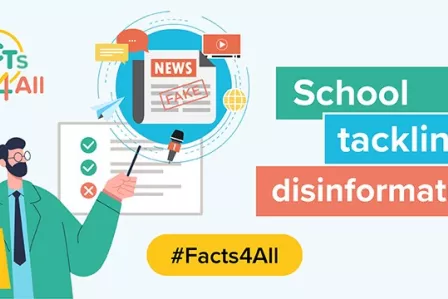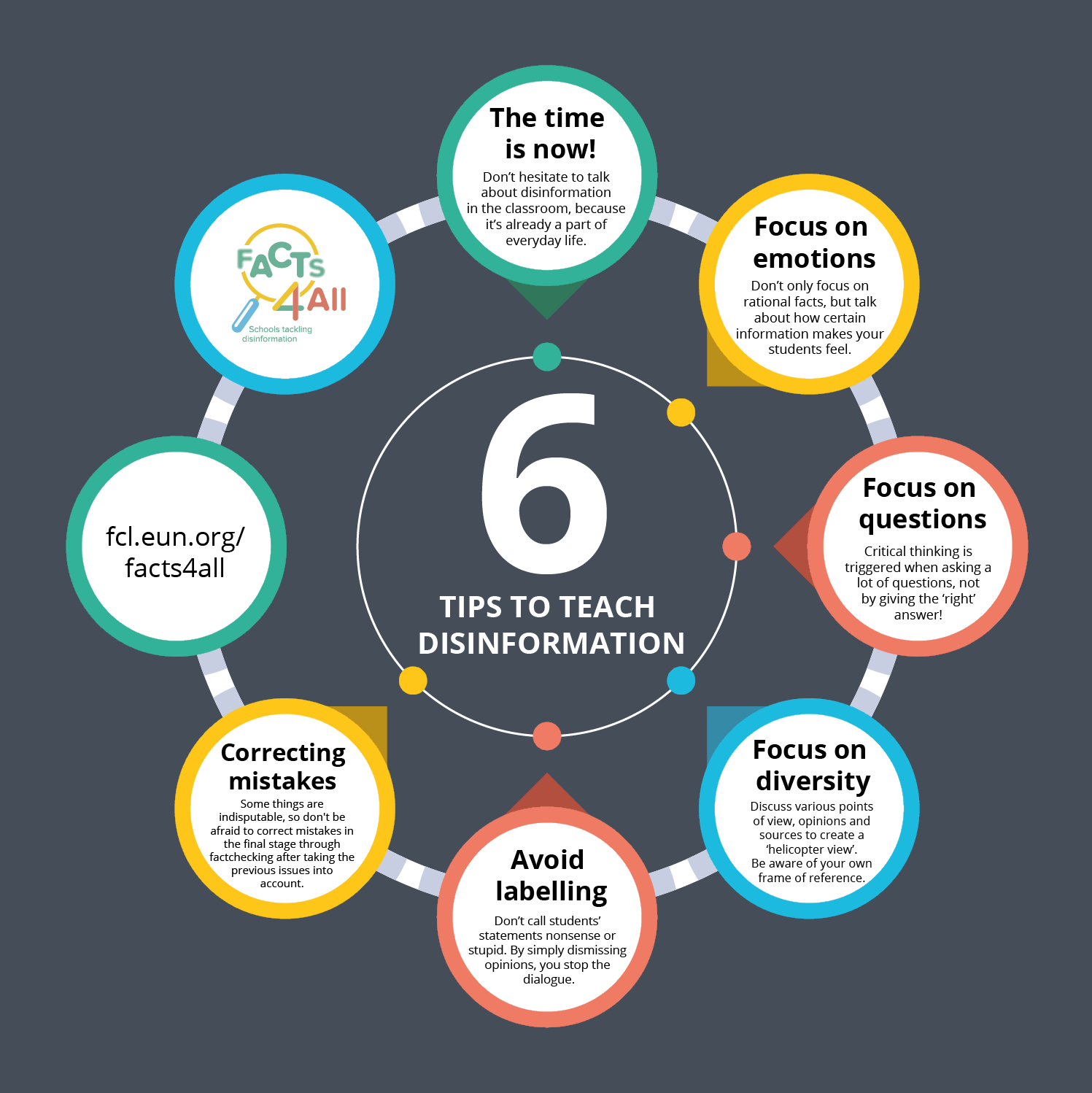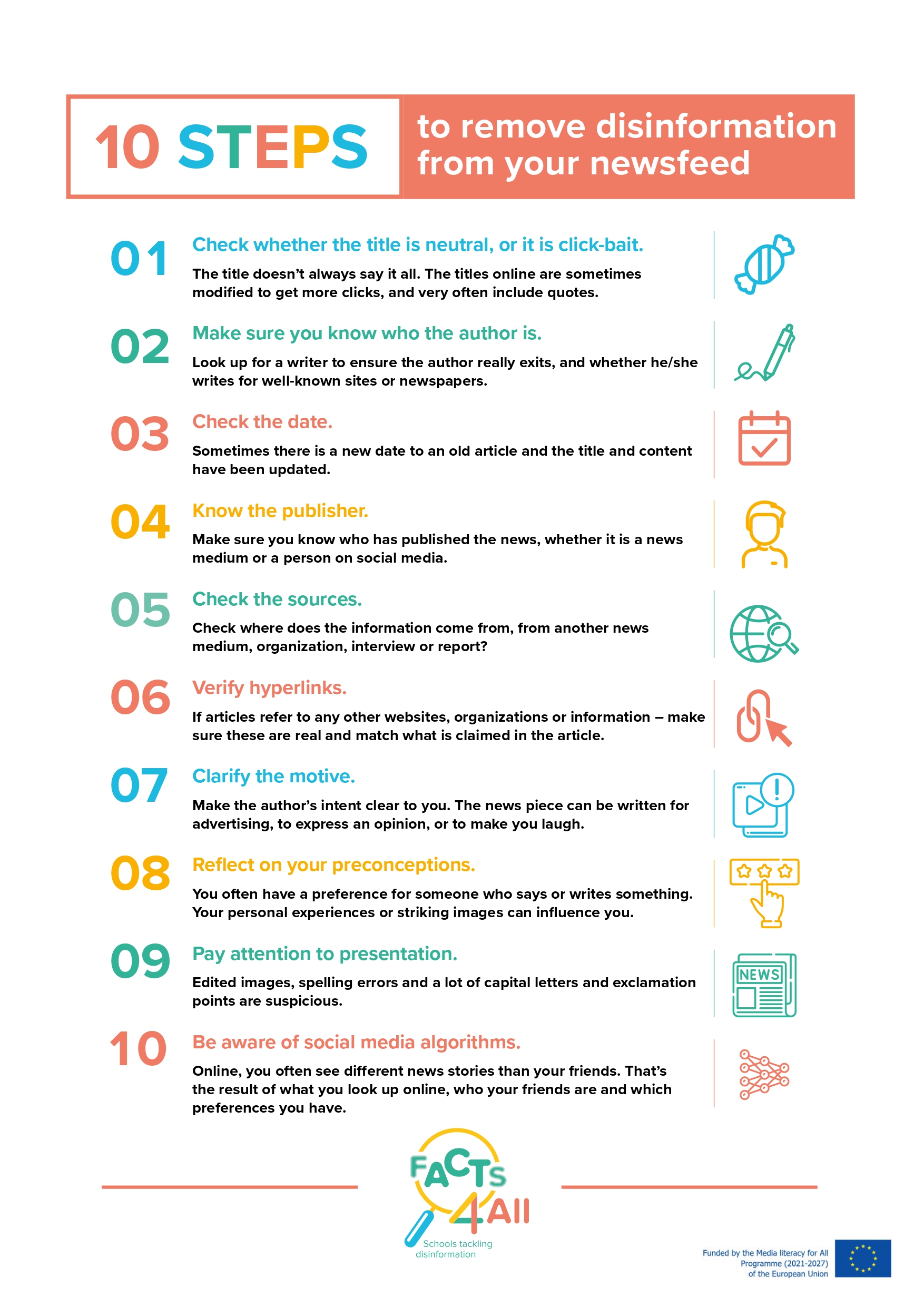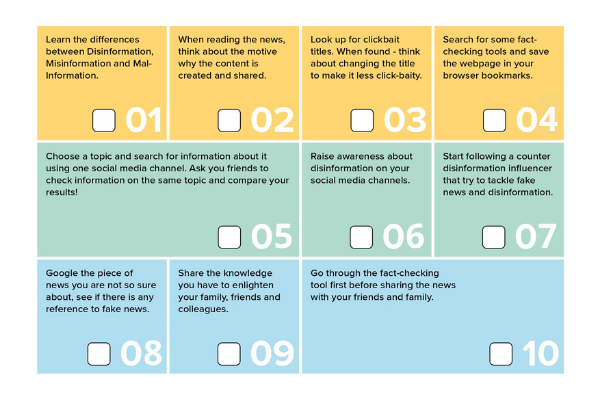Fake news travels very fast. According to findings from the Massachusetts Institute of Technology research, false news spreads six times faster on Twitter than truthful stories. An overabundance of information makes it hard for users to find trustworthy and reliable sources and, most importantly, identify false and misleading content online. The Facts4All – School tackling disinformation project recently launched an online campaign with the aim of raising awareness of online disinformation, while also providing guidance on how best to consume online content.

Teaching media literacy
Recognising that we are living in a period of information overload and experiencing a crisis of trust in information, Facts4All looks at the phenomenon of information disorder from the educational point of view. Based on input from the Insafe network of Safer Internet Centres in Europe, as shared at the last Insafe Training meeting in the autumn of 2021, there are many teachers in Europe who don’t feel confident or knowledgeable to address social media literacy topics in schools. Some teachers find themselves ‘lost’ in amongst the proliferation of new social media channels and in the roles and functional capacities these platforms have. In brief, the rise in popularity of (social) media requires a new approach to the teaching of social media literacy.
In this context, Facts4All launched a massive open online course (MOOC) – Schools tackling disinformation, that aims to help primary and secondary teachers to foster critical thinking skills and tackle online disinformation in schools. The course provides teachers and other educational professionals with tools and tips on how to engage students in conversations on disinformation and media literacy.

Image: Facts4All infographic - Six tips to teach disinformation
Facts4All #OnlyFacts awareness-raising campaign on disinformation
Over the last month or so, Facts4All has been running an #OnlyFacts awareness-raising campaign with the slogan ‘Take action – tackle disinformation’. While the MOOC is mostly addressed to teachers and educational professionals, the campaign aims to convey the message to all citizens; that is, all internet users who consume information online.
Why do we need to raise awareness about disinformation?
Putting a spotlight on the issue of information disorder is crucial. In line with the current global events, the need to raise awareness about the reliability and accuracy of the sources people use to receive their news has become more important than ever. The news flows around the COVID-19 pandemic and the war in Ukraine, for example, have proven that consuming misleading or factually inaccurate information can lead to negative consequences, even when it is spread unknowingly.
It is also important to mention that the consumption of information and news online is not always neutral. In most cases, one’s online experience is hyper-customised and multilayered, and is based on many factors, such as location, the accounts we follow on social media, social media algorithms, and sponsored posts or advertisements.
Furthermore, it has become easier to replicate and share fabricated and manipulated content on the internet. Due to the nature of the internet, such content can be shared between many users and communities within minutes with no clear indication of the original source. Hence, it makes tracking the sources of different types of information increasingly difficult.
In turn, identifying misleading or false information has become more complex and challenging. However, this complexity doesn’t mean that we shouldn’t attempt to do so.
The Facts4All approach to providing knowledge on information disorder
To tackle disinformation, we need to understand what type of content is out there, and why and how social media posts are produced, shared and disseminated. The Facts4All campaign aims to provide an understanding on how to detect and recognise false and misleading online content. As such, the communication materials are focused on answering the following questions:
- Why do we need to talk about information disorder?
- Where do we get our information from?
- What is the difference between mis-, dis-, and mal- information?
- What types of misleading information exists?
- Why do people share misleading content online?
- How is misleading information spread online?
- How can we teach people about information disorder?
- What needs to be done to tackle disinformation?
To address these questions, nine short educational videos have been produced. These can be viewed and downloaded on the campaign’s webpage.
What steps do we need to take to tackle disinformation?
Among many activities initiated in the month of March, Facts4All released a check-guide on what elements need to be verified to consider a piece of content trustworthy. The guide ’10 steps to remove disinformation from your newsfeed’ is suitable for those users who wish to have a structured way to evaluate a piece of news they encounter online.  Image: Facts4All infographic - 10 steps to remove disinformation from your newsfeed
Image: Facts4All infographic - 10 steps to remove disinformation from your newsfeed
To round off the campaign’s focus on taking practical steps to tackle disinformation, Facts4All launched an online challenge ‘Take action – tackle disinformation’, where the audience is invited to carry out 10 simple actions over the course of 10 days to increase the quality of their online experience.
 Image: Facts4All infographic – challenge ‘Take action – tackle disinformation’
Image: Facts4All infographic – challenge ‘Take action – tackle disinformation’
Campaigns like this serve as a tool to close the gaps in media literacy education. Spreading awareness about information disorder not only prevents children and young people from consuming fake and misleading news, but it can also help to embrace the more active and safe usage of social media tools. These efforts aim to make a positive – and much needed – difference to society.
____________________________________________________________________________________________________
For more information about the Facts4All project, please see the website at fcl.eun.org/facts4all.
To view and download the Facts4All campaign resources, please visit the dedicated page #OnlyFacts awareness-raising campaign on disinformation.
Learn more about the Facts4All MOOC and register for the course here.
Follow #Facts4All and support the Facts4All campaign!
Fake news travels very fast. According to findings from the Massachusetts Institute of Technology research, false news spreads six times faster on Twitter than truthful stories. An overabundance of information makes it hard for users to find trustworthy and reliable sources and, most importantly, identify false and misleading content online. The Facts4All – School tackling disinformation project recently launched an online campaign with the aim of raising awareness of online disinformation, while also providing guidance on how best to consume online content.

Teaching media literacy
Recognising that we are living in a period of information overload and experiencing a crisis of trust in information, Facts4All looks at the phenomenon of information disorder from the educational point of view. Based on input from the Insafe network of Safer Internet Centres in Europe, as shared at the last Insafe Training meeting in the autumn of 2021, there are many teachers in Europe who don’t feel confident or knowledgeable to address social media literacy topics in schools. Some teachers find themselves ‘lost’ in amongst the proliferation of new social media channels and in the roles and functional capacities these platforms have. In brief, the rise in popularity of (social) media requires a new approach to the teaching of social media literacy.
In this context, Facts4All launched a massive open online course (MOOC) – Schools tackling disinformation, that aims to help primary and secondary teachers to foster critical thinking skills and tackle online disinformation in schools. The course provides teachers and other educational professionals with tools and tips on how to engage students in conversations on disinformation and media literacy.

Image: Facts4All infographic - Six tips to teach disinformation
Facts4All #OnlyFacts awareness-raising campaign on disinformation
Over the last month or so, Facts4All has been running an #OnlyFacts awareness-raising campaign with the slogan ‘Take action – tackle disinformation’. While the MOOC is mostly addressed to teachers and educational professionals, the campaign aims to convey the message to all citizens; that is, all internet users who consume information online.
Why do we need to raise awareness about disinformation?
Putting a spotlight on the issue of information disorder is crucial. In line with the current global events, the need to raise awareness about the reliability and accuracy of the sources people use to receive their news has become more important than ever. The news flows around the COVID-19 pandemic and the war in Ukraine, for example, have proven that consuming misleading or factually inaccurate information can lead to negative consequences, even when it is spread unknowingly.
It is also important to mention that the consumption of information and news online is not always neutral. In most cases, one’s online experience is hyper-customised and multilayered, and is based on many factors, such as location, the accounts we follow on social media, social media algorithms, and sponsored posts or advertisements.
Furthermore, it has become easier to replicate and share fabricated and manipulated content on the internet. Due to the nature of the internet, such content can be shared between many users and communities within minutes with no clear indication of the original source. Hence, it makes tracking the sources of different types of information increasingly difficult.
In turn, identifying misleading or false information has become more complex and challenging. However, this complexity doesn’t mean that we shouldn’t attempt to do so.
The Facts4All approach to providing knowledge on information disorder
To tackle disinformation, we need to understand what type of content is out there, and why and how social media posts are produced, shared and disseminated. The Facts4All campaign aims to provide an understanding on how to detect and recognise false and misleading online content. As such, the communication materials are focused on answering the following questions:
- Why do we need to talk about information disorder?
- Where do we get our information from?
- What is the difference between mis-, dis-, and mal- information?
- What types of misleading information exists?
- Why do people share misleading content online?
- How is misleading information spread online?
- How can we teach people about information disorder?
- What needs to be done to tackle disinformation?
To address these questions, nine short educational videos have been produced. These can be viewed and downloaded on the campaign’s webpage.
What steps do we need to take to tackle disinformation?
Among many activities initiated in the month of March, Facts4All released a check-guide on what elements need to be verified to consider a piece of content trustworthy. The guide ’10 steps to remove disinformation from your newsfeed’ is suitable for those users who wish to have a structured way to evaluate a piece of news they encounter online.  Image: Facts4All infographic - 10 steps to remove disinformation from your newsfeed
Image: Facts4All infographic - 10 steps to remove disinformation from your newsfeed
To round off the campaign’s focus on taking practical steps to tackle disinformation, Facts4All launched an online challenge ‘Take action – tackle disinformation’, where the audience is invited to carry out 10 simple actions over the course of 10 days to increase the quality of their online experience.
 Image: Facts4All infographic – challenge ‘Take action – tackle disinformation’
Image: Facts4All infographic – challenge ‘Take action – tackle disinformation’
Campaigns like this serve as a tool to close the gaps in media literacy education. Spreading awareness about information disorder not only prevents children and young people from consuming fake and misleading news, but it can also help to embrace the more active and safe usage of social media tools. These efforts aim to make a positive – and much needed – difference to society.
____________________________________________________________________________________________________
For more information about the Facts4All project, please see the website at fcl.eun.org/facts4all.
To view and download the Facts4All campaign resources, please visit the dedicated page #OnlyFacts awareness-raising campaign on disinformation.
Learn more about the Facts4All MOOC and register for the course here.
Follow #Facts4All and support the Facts4All campaign!
- misinformation media literacy massive open online course (MOOC) disinformation
Related content
- < Previous article
- Next article >









